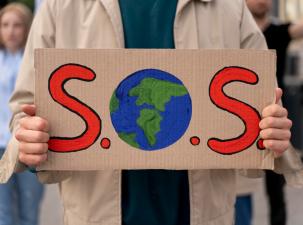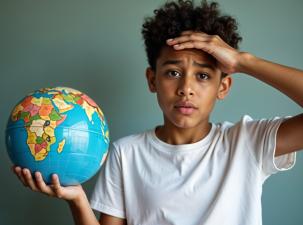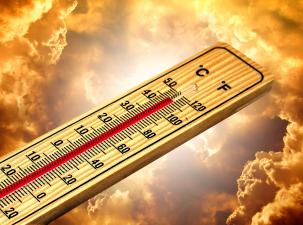Consequences

➡️ Climate Change Consequences – Impact on People and our Planet
Increased greenhouse gas emissions into the Earth's atmosphere have triggered global warming and disrupted climate systems. As the climate crisis intensifies, the frequency and severity of extreme weather events worsen.
In 2024, the world experienced its hottest year on record. During the same year, Southeast Asia endured unprecedented flooding which displaced millions, wildfires devastated Europe and North America, and prolonged droughts plunged parts of Africa into famine and severe food insecurity.
The global economic loss from natural disasters in 2024 exceeded $320 billion - 40% higher than the annual average for that decade.
Climate change is now the single biggest health threat facing humanity, with far-reaching consequences. No corner of the Earth has been left untouched by the impacts of our changing climate.
Jump straight to our resources on ➡️ the Consequences of Climate Change
Explore our comprehensive guides on -

The Emergency Events Database reports a record rise in natural disasters globally since the 1960s, detailing over 26,000 mass disasters. The number of reported natural disaster incidents increased from 39 in 1960 to 399 in 2023.
Annually, 218 million people are affected by natural disasters - 68,000 lives are lost every year. The impacts of natural disasters are unevenly distributed. Some regions are more prone due to geographical factors, and some are more vulnerable due to economic and social factors. These climate-sensitive regions are victims of climate injustice as those who historically contributed least to the climate crisis are suffering the worst effects of it. More than 91% of extreme weather-related deaths occur in developing countries, further demonstrating the unequal burden of marginalised and vulnerable populations.

Impacts of Climate Change
RISING TEMPERATURES & HEATWAVES
The planet's surface temperature has risen about 1.1°C since the late 19th century, driven mostly by increased carbon dioxide emissions from the combustion of fossil fuels. Rising temperatures are impacting human health, our ecosystems, and biodiversity, as well as fueling weather-related disasters such as heatwaves, drought, and wildfires.
The increased incidence of heat waves is one of the clearest links between climate change and extreme weather. In the decade following 2010, the U.S. experienced heatwaves an average of six times a year – three times more frequently than during the 1960s. In 2022, over 60,000 people died from heat-related stress during the European heatwaves.
Rising temperatures and drier conditions have increased the risk and extent of wildfires globally. The number of large wildfires in the western United States has doubled between 1984 and 2015.
Wildfires are burning at least twice as much tree cover today as they did two decades ago. They are also a leading cause of financial loss. Wildfires in the United States cause between $394 billion and $893 billion in damages annually.

MELTING GLACIAL ICE & RISING SEA LEVELS
The global rate of sea level rise has increased by 50% in the past 30 years. Current mean sea level rise is 3.6 mm per year. Our oceans absorb 25% of all carbon dioxide emissions and capture 90% of the excess heat generated by them. The ocean is the lungs of our planet and our largest carbon sink.
The average ocean surface temperature has increased by 0.6°C over the last four decades. When water heats up, it expands. This thermal expansion is the number one cause of rising sea levels.
Glacial melt, also caused by rising temperatures, is responsible for 21% of sea level rise over the past two decades. Research shows glaciers collectively lost 6.5 trillion tonnes of ice between 2000 and 2023. Rates of glacial thinning have nearly doubled.
Glacial melting also leads to a depletion in freshwater supplies for nearby communities already facing water scarcity. Two billion people depend on meltwater from glaciers. Two-thirds of global irrigated agriculture will soon be affected by receding glaciers and decreasing levels of snowfall.
Meltwater from ice sheets in Greenland and Antarctica is responsible for about one-third of the global average rise in sea level since 1993. Greenland is the largest regional source of sea level rise, losing around 270 billion tonnes of ice mass annually.
If all our planets' glaciers and ice sheets melted, global sea level would rise by more than 195 feet!

OCEAN ACIDIFICATION
Increased carbon dioxide levels are causing oceans to become more acidic, which harms marine life, particularly organisms with calcium carbonate shells, like corals and shellfish.
Since the beginning of the Industrial Revolution, the ocean has absorbed some 525 billion tons of CO2 from the atmosphere. Between 1950 and 2020, the average pH of the ocean surface fell from approximately 8.15 to 8.05.
Increased acidification reduces the ability of organisms to build their shells or skeletons. Over 50% of coral reefs have died since the 1950s, destroying an important ocean habitat for other creatures.
Lower pH levels also impact fish which are experiencing lowered immune response, metabolic decline, and reproductive issues. With a predicted decrease in global fish production of 2-13%, food security and livelihoods in coastal regions are under serious threat.

HURRICANES & FLOODING
Increasing atmospheric and ocean temperatures are increasing the intensity of hurricanes. Stronger winds, heavier and more prolonged rainfall, higher storm surges, and slower-moving storm systems are increasing hurricane damage around the world. The 2024 Atlantic hurricane season was marked by record-setting storms, and the earliest-ever category 5 hurricane was recorded.
The proportion of category 3 or higher hurricanes in the Atlantic Ocean has doubled since 1980. In the case of Hurricane Milton, wind speeds increased by a massive 90mph in just 24 hours, one of the most extreme intensifications on record.
One of the most costly hurricanes in U.S. history was Hurricane Katrina in 2005. A storm surge of 26 feet resulted in more than 50 breaches in the levees surrounding New Orleans, flooding 80% of the city.
Floods are the most common natural disaster. In 2021, global flood losses cost the economy $105 billion, rendering more than a million people homeless and destroying communities, livelihoods, agricultural land, and lives.
For every one-degree Celsius rise in temperature, our Earth's atmosphere can hold 7% more water vapour, resulting in more intense rainfall and increased chances of flooding. This is exasperated by rapid urbanisation and other effects of climate change, such as heatwaves and droughts, which create parched soils.
World Weather Attribution concluded that climate change has increased the volume of rainfall by 3-19%. Since 1985, the number of people living in areas categorised as a very high flood risk has risen by 122%; these areas are mostly in South and East Asia.

DROUGHT & HUNGER
Over the next few decades, the United Nations predicts climate change-driven drought will affect 129 countries. Most at risk are low- and middle-income nations with insufficient resources to adapt and cope with changing conditions. Climate change contributes to hotter and drier weather, causing droughts to occur more frequently and last longer.
Between 1994 and 2013, drought affected more than one billion people. Water scarcity now impacts 40% of the world's population. With no alternative, communities are forced to drink contaminated water, which leads to serious health problems. Crops fail, livestock perishes, and livelihoods are destroyed. When hunger and poverty take hold, displacement, disease, and death follow.
Extreme drought affects Africa more than any other continent. One person in East Africa dies of hunger every 28 seconds. Oxfam predicts that 700 million people are at risk of being displaced due to drought by 2030.
Forests act as a key defence against drought. They bind the soil, preventing erosion, release moisture into the atmosphere, and help to slow desertification. However, unchecked logging and deforestation for livestock grazing and agriculture are worsening drought conditions and contributing even further to climate change.

BIODIVERSITY LOSS
Changes in climate affect ecosystems and the species that live within them. Many plants and animals struggle to adapt to shifting conditions, leading to biodiversity loss and the potential extinction of vulnerable species.
Extreme environmental changes such as desertification and melting ice sheets can make areas uninhabitable. The polar bear is now listed as a vulnerable species, and sea ice loss from global warming is the biggest threat to its survival. In Canada's Hudson Bay, a survey from 2021 revealed that the population has fallen by 27% in just five years.
Disruptions to weather patterns impact animal and bird migration, and reproduction times fall out of sync. Birds arrive at breeding grounds too early when food sources are scarce, seriously affecting their survival and that of their offspring.
In the last 40 years, wildlife populations have declined on average by 69% - 1,000–10,000 faster than natural rates. If global mean temperatures rise by 2.5°C, 20-30% of plant and animal species could die out.
Human-wildlife conflict is also increasing due to climate change. As natural habitats diminish and food becomes limited, wildlife is increasingly pushed toward human communities. Other impacts of climate change include weather-related disasters, which destroy entire ecosystems. Australia's 2019-20 bushfires burnt 19 million hectares of land and affected 3 billion animals.

REDUCED AGRICULTURAL YIELDS
Altered weather patterns and extreme conditions disrupt food production, leading to food insecurity and higher prices. Unpredictable changes in weather patterns bring extreme heat and cold and either a lack of rain or too much. Climate change also alters pest and disease outbreaks, exposing areas to unfamiliar risks.
After suffering recurrent droughts, East Africa is experiencing widespread crop failures, loss of livelihoods, and massive internal displacement. In 2022, 85% of cropland in Ethiopia had been affected. The drought killed millions of livestock and plunged the population into famine and poverty.
Small-scale farmers in Asia and sub-Saharan Africa are the most vulnerable to climate change, yet they are the least responsible for it. Its impact on agriculture is accelerating poverty, hunger, and inequality. If temperatures continue to rise, rice yields in Asia could drop as much as 50% by the end of the century.
THE FINANCIAL COSTS OF CLIMATE CHANGE
Over the past 2 decades, extreme weather events globally have cost an estimated $2.8 trillion. This includes damage to infrastructure, poverty, agriculture, and human health. This amount will keep increasing as the impacts of climate change become more severe.
The vast majority of damage was caused by storms, hurricanes, and typhoons. Heatwaves accounted for 16%, flooding and drought 10%, and wildfires 2%. Hurricane Katrina tops the list as the single biggest one-off climate-related disaster, costing $125 billion in damage.
The Loss and Damage fund was created at COP27, the 2022 climate conference. This fund is to compensate developing countries for losses and damages (L&Ds) from natural disasters caused by climate change, for which wealthy countries are disproportionately responsible. Hailed as a major milestone at the time, financial commitments have fallen well below the $400 billion needed annually to address L&Ds and climate injustices sufficiently.

INCREASED CONFLICT OVER LIMITED RESOURCES
As resources become scarcer and natural disasters more common, social and political tensions rise, leading to conflicts and mass displacement of populations. The climate crisis has influenced 3-20% of armed conflicts over the last century, serving only to make the vulnerable even more at risk.
As climate change intensifies, more people will be forced to leave their homes. Neighbouring countries that are already struggling will become unable to cope with the influx of refugees. Sharing already scarce resources, such as agricultural land and water, almost always leads to more conflict.
In 2024, one person was displaced per second due to extreme weather events. Those displaced by both conflict and the impacts of climate change are extremely unlikely to be able to return home.
Drought, flooding, pests, soil erosion, and poor governance have created increasingly precarious and complicated situations for millions. Sudan's civil war is often described as the first climate change-induced conflict in a deadly mix of conflict, economic crisis, and drought.
In the years leading up to the conflict, northern Sudan was gripped by the southerly expansion of the Sahara Desert at a rate of almost one mile per year. At the same time, annual median rainfall decreased between 15-30%. Peaceful coexistence between ethno-African and Arab farmers eroded as pastures shrank. The resulting war left 5 million people food-insecure, and an official famine was declared in 2017.
Climate Change Solutions for a Better World
The vast proportion of most severe extreme weather events in 2024 occurred in developing nations. This year alone, the Amazon River in Colombia dropped by 90%, heatwaves affected 33 million people in Bangladesh, West Africa was hit with unprecedented floods which affected more than 6.6 million people in Nigeria, Chad and Niger, and Southern Africa experienced the worst droughts in memory affecting more than 14 million people in Zambia, Malawi, Namibia and Zimbabwe.
The human suffering caused by the climate crisis reflects poor political choices, a lack of mitigation strategies, and short-sightedness. We simply must end our reliance on coal and fossil fuels, commit to a renewable energy future, reforest, rewild, de-intensify agricultural practices, embrace Indigenous knowledge, build resilience, repay our climate debts, share the skills and technology needed for a fast energy transition, and strictly monitor and enforce emissions targets.
To fully utilise these tools and solutions, governments and world leaders need to step up and enforce large-scale implementation. Public pressure must continue to push governments to act sooner rather than later. We are failing all our climate targets, and there is still no legal requirement to reach them.
Author: Rachael Mellor, 02.04.25 licensed under CC BY-SA 4.0
For more information on the Consequences of Climate Change see below ⬇️
Info on Consequences
- 1.5°C - IPCC study[84]
- General Info[65]
- Wildfires[1185]
- Rising Sea Levels[368]
- Hurricanes & Floodings[1414]
- Heat Waves[796]
- Extreme Weather Events[284]
- Extreme Cold Weather[119]
- Climate Refugees[352]
- Financial Costs of Climate Change[275]
- Climate Change & Conflict[161]
- Impact on Agriculture[254]
- Arctic Ice & Permafrost
- Droughts & Hunger[329]
- Gulf Stream / AMOC Collapse[43]
- Glacier & Sea Ice Melt[56]
- Other consequences[267]




